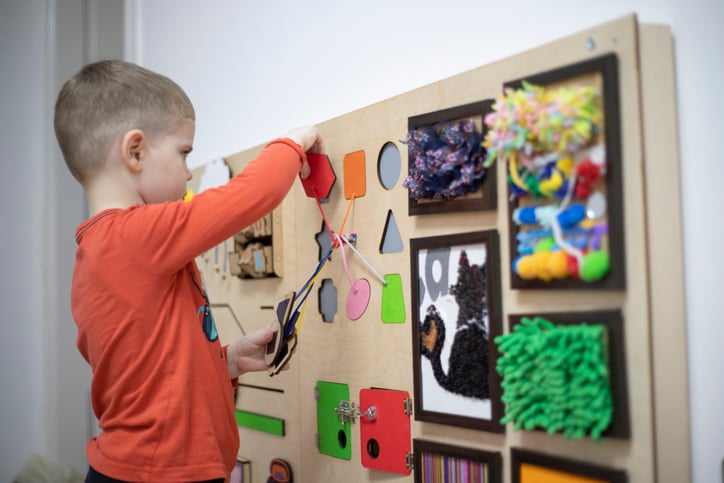How to Set Up a Homeschool Classroom for Your Autistic Child: 10 Key Strategies
Setting up space in your home to homeschool your autistic child is where your own creativity can come into play. Even in a small home and on a tight budget there are ways to design your space that can have an enormous impact on how well your autistic child can focus and learn. The key is to do a little up-front planning based on the tips below, and then tweak and modify as needed for your child.
Start by setting up a dedicated place in your home for homeschooling. Next, set up a Command Center to help you stay organized. Think about ways to customize your learning area so that it will work best for your child. This can include creating a sensory corner, choosing tech tools, and designing a space that can incorporate outdoor learning and that is optimized for frequent movement and flexibility.
Here are the 10 key recommendations for setting up your homeschooling space for your autistic child:
1. Set Up a Space Devoted to Homeschooling
Choose a special part of your home that can be devoted to learning time. This can be a spare room or even a part of your living room or kitchen. The key to success is having the area clearly designed for learning. If you have the space, devote one room just to learning.
If you have less space, think about how to transform your kitchen or dining room area into a classroom between specific hours of the day and then transform it back to a regular room when learning is finished for the day. Consider using a rolling cart that contains all the materials you need for the school day. At the end of the “school day,” you can set up the cart for what you will need in the morning, and then cover it with a sheet so that the family can focus on other enjoyable activities.
2. Set Up Your Command Center
Organize a space where all the materials and resources you are using for homeschooling can be found. You can use bins, a specific set of shelves, or even a set of laundry bins. Also, use containers for pencils, markers, and other smaller items. Label everything! Use color themes to organize your homeschool supplies, such as always using red notebooks.
If your homeschooling space is set up in your kitchen, but you do not have room for your Command Center in the kitchen, set it up in a nearby room. What is most important is having it all sitting in one specific spot so you can pull things out as needed.
The ARIS® Academic Readiness Intervention System Curriculum is great because it comes in one large green tub and everything you need to teach the curriculum is included: from picture cards to manipulatives, to lesson plans, to data tracking sheets. Each lesson plan walks you through the steps of conducting a lesson, and you do not have to be an experienced teacher or ABA therapist to teach these lessons.
3. Design the Space With Your Child in Mind! Hint: It Does Not Have to Look Like a Classroom!
One of the advantages of homeschooling your autistic child is that the learning area can be designed to play to your child’s strengths. If your child learns best while jumping on a mini trampoline while answering questions, then have a mini trampoline available! You do not need to have a conventional student desk and whiteboard.
Think about seating options, movement opportunities, weighted blankets or vests, and other ways that will help your child focus on school activities. Do not be afraid to experiment. The beauty of homeschooling is that you get to make changes whenever anything does not seem to be working for your child. Does your child pay attention more when you are outside or in a small quiet space? Think about the times when your child has been able to concentrate on certain tasks that are similar to school tasks or times when they have been best able to respond when you are asking them to do something. What does the environment around them look like when your child is having successful experiences?

4. Create a Sensory Corner in Your Homeschool Classroom
Consider creating a sensory center within your homeschool space. Does your child thrive in a muted and quiet space? Or an area that is brightly lit and has warm vibrant colors? Think about incorporating different textures such as a beanbag chair or a fuzzy or smooth carpet square to sit on.
If you are teaching more than one child, make sure there are choices for children who are sensory seeking versus sensory avoiding. Consider the following for children who are sensitive to touch, visual, auditory, and smell stimuli:
- Tactile:
Try different types of fidget tools such as wiggle cushions, stress balls, and fidget items. Use rocking chairs or bean bags so that students can try moving while learning. - Auditory:
Try using noise-canceling headphones, white noise machines, or whisper phones that can help your child concentrate on what is being said to them. Desensitize a child to predictable noises by slowly integrating him or her into the environment, potentially repeatedly - Visual:
Try limiting clutter around the home classroom or learning space; label and organize materials and put things away after using; use pictures to show where school items can be put away - Olfactory: Pay attention to whether your child seems to be reactive to certain scents or smells and try to minimize these. Also, think about some scents that your child might enjoy. Though the research on aromatherapy and autism is limited, some scents such as peppermint and lavender seem to help children calm down.
5. Choose When, What, and How to Use the Best Technology for Your Autistic Child
It can be tempting to think that because autistic kids tend to enjoy digital activities, these online computer programs can be the heart of your homeschooling curriculum. However, research indicates that it is best to break up the day between some online learning and some print-based and hands-on activities.
For younger children, it is especially important to limit screen time, but for older children as well, be sure to break up the day with exercise, social interaction, and outdoor adventures.
6. Create an Outdoor Classroom
Creating an outdoor learning space for your child should be intentional, but it does not have to be overly complicated. Take advantage of what is already outside to help your child focus on new learning activities. Many things that are traditionally taught inside can also be taught outside: reading, math, and science activities can all be designed to work in outdoor learning areas.
7. Add Movement Into Many Learning Activities
This will vary from child to child, but sometimes the ideal is to break up periods of sitting with periods of more active learning. There are many creative ways to add movement into learning, such as climbing stairs while learning addition, using songs with movement pieces to improve motor skills, creating a hopscotch game where children jump on letters to spell words, and practicing matching skills with objects found around the house.
While some parents may try to adapt every learning activity to include movement, it can also be important to help your child learn to sit quietly and do their school work, even if this is just during short intervals of time as you gradually build their capacity for sitting still. For some children, this might mean starting at 5 or 10 minutes and gradually building up the time they can sit still and focus.

8. Stay Organized and on Track With a Visual Wall Schedule
Autistic children tend to be strong visual learners and learn best with real photo images rather than text or cartoon images. The Language Builder Picture Nouns are especially useful for creating a visual wall calendar.
For planning the school day, try setting up a bulletin board with Velcro and create 3 x 5 cards with images of what is planned for the day, or use the Language Builder cards. These cards can be re-used as needed. For example, if the day starts with a reading activity have one card that has an image of a book on it. For multiple children, you can have vertical schedules for each child, with an image of the child at the top of it.
If a bulletin board or magnetic whiteboard is not an option, use a binder or clipboard that can accommodate the cards. As you complete activities you can ask your child to remove the card from the schedule. You can also incorporate one or two “wild cards” that the child can use at a time that works best for taking a learning break to play a short fun game or engage in a movement activity.
9. Create an “On the Fly” Classroom
Create a “go bag” for those times when you need to take a trip to a doctor’s appointment or go on an errand so that you can bring planned learning activities with you on the road. For any family, there may be many visits to dentists, doctors, therapists, and others. Try to not let it be too disruptive to your school day.
Because homeschooling can be so flexible, if you are intentional, you can have a plan to quickly transition the learning activities so that they can be completed in cars and waiting rooms. Loading up music, videos, and storybooks to your devices ahead of time can provide you with some quick “go-to” activities.
Having an appointment scheduled at the last minute does not have to take a lot of extra planning. You can have a fun learning activity preloaded into your “go bag” that introduces a new topic of study to your child. Or you can choose activities that relate to going to the dentist or doctor.
10. Evaluate and Modify Your Homeschooling Space
The beauty of homeschooling is that if something is not working you can change it! It is important to get in the mindset of asking yourself every week or so if something needs to be modified. Having an autistic or special needs child means that sometimes the pace of your child’s learning will be much slower than you want it to be. That does not mean your homeschooling is not working.
Consider joining a homeschooling collaborative or co-op or joining a special needs homeschooling support group. Ask members to help you troubleshoot anything that does not seem to be working smoothly and volunteer to show them what is working particularly well in your homeschool.

L.F. Stebbins, M.Ed. M.L.I.S.
L.F. Stebbins has more than twenty-five years of experience in higher education with a background in library and information science, instructional design, research, and teaching. She has an M.Ed. from the Technology Innovation & Education Program at the Harvard Graduate School of Education and a Masters in Information Science from Simmons College. For twenty years she created and led media literacy and research skills programs for students and faculty at Brandeis University. Currently she is the Director at research4Ed.com and the Director for Research at Consulting Services for Education (CS4Ed). For more about Leslie visit LeslieStebbins.com.




